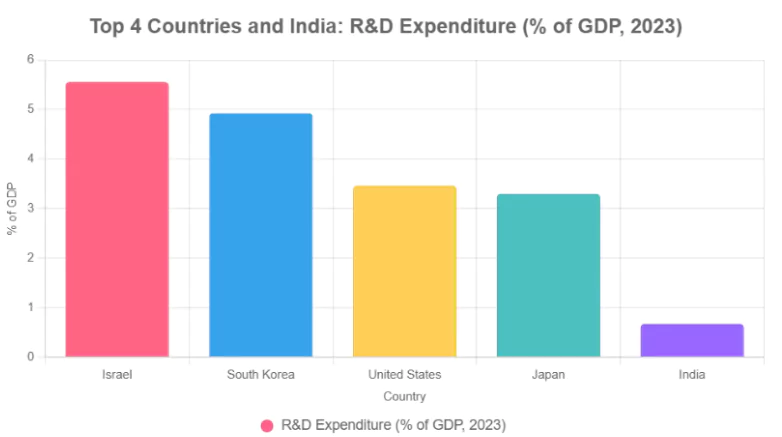Union Minister Dr. Jitendra Singh announced transformative policy reforms to enhance the “Ease of Innovation,” “Ease of Research,” and “Ease of Science” in India, aimed at streamlining research and development (R&D) processes.

Major Policy Changes
- Non-GeM Procurement: Research institutions can bypass Government e-Marketplace (GeM) for specialized equipment unavailable on the platform.
- Directors and Vice Chancellors (VCs) empowered to make direct procurement decisions.
- Increased Financial Autonomy:
- Revised General Financial Rules (GFR) ceilings:
| The GTE is a procurement process where the implementing institutes seek competitive offers from abroad when goods of the required quality are not available domestically. |
-
-
- Direct purchases: Raised from ₹1 lakh to ₹2 lakh.
- Departmental committee purchases: Increased from ₹1-10 lakh to ₹2-25 lakh.
- Limited tender enquiries/advertised tenders: Upped from ₹50 lakh to ₹1 crore.
- Global Tender Enquiries (GTEs): Heads of institutions can approve GTEs up to ₹200 crore (previously a central authority privilege).
Rationale Behind Reforms
- Addressing Bureaucratic Bottlenecks: Mandatory GeM procurement caused delays for specialized research equipment not available on the portal.
- Allow non-GeM purchases for niche scientific tools (e.g., gene sequencers, particle accelerators).
- Accelerating Scientific Output: India ranks 3rd in research publications but lags in commercialization (just 0.7% of global patents).
- Reduce project delays (e.g., 6–12 months for equipment imports) to boost innovation.
- Empowering Institutional Leaders
- Trust-Based Autonomy: Directors/VCs can now approve:
- Global tenders up to ₹200 crore (vs. earlier central approval).
- Faster procurement via raised financial ceilings (e.g., ₹1L→₹2L for direct purchases).
- Mirrors ISRO’s decentralization success in mission-critical procurements.
- Aligning with National Priorities
- NEP 2020: Supports interdisciplinary research by easing lab infrastructure constraints.
- Atmanirbhar Bharat: Facilitates access to global tech while building domestic R&D capacity.
- Learning from Global Best Practices
- US Model: NSF grants allow universities procurement flexibility.
- EU’s Horizon Europe: Simplified funding rules boosted researcher participation.
About Government e Marketplace (GeM)
- GeM is a one stop portal to facilitate online procurement of common use Goods & Services required by various Government Departments / Organizations / PSUs.
- Aim: Launched in 2016, it aims to enhance transparency, efficiency and speed in public procurement.
- Nodal Ministry: Ministry of Commerce
- Mandatory Purchase by Government Entities: The purchases through GeM by Government users have been authorized and made mandatory by the Ministry of Finance.
|
Status of Research and Development (R&D) in India
- Government Investment in R&D
- Gross Expenditure on R&D (GERD): India’s GERD has increased from ₹60,196.75 crore in 2010–11 to ₹127,380.96 crore in 2020–21.
- However, the GERD as a percentage of GDP is around 0.7%, which is lower than global benchmarks.
- Source of Funding: Public sector funding dominates, accounting for around 63% of total R&D expenditure. Private sector contributions are low, at around 7%.
- Union Budget 2025-26, has allocated ₹20,000 crore to the Department of Science and Technology (DST) to initiate a private sector-driven research and development (R&D) fund .
- Research Infrastructure
- Top Institutions: Institutions like IITs and IISc lead in research with state-of-the-art facilities. They produce high-quality research output.
- Higher Education: India is the third-largest higher education system globally, following the U.S. and China.
- Research Output
-
- Publications: India ranked third in research publications with over 3,00,000 outputs (2022). Citation quality often lags behind global leaders.
- Patents: India is ranked 6th globally for patent filings. Converting academic research into commercial products remains limited.
- International Collaboration: India actively participates in global research partnerships but faces challenges in securing international funding.
International Collaborations
- Global Partnerships: India has been actively involved in international collaborations in fields such as space research, healthcare, and information technology. These collaborations help India access global expertise, advanced technologies, and funding.
- Space Research: India’s space agency, ISRO, has collaborations with NASA, the European Space Agency (ESA), and other countries.
- For example, the Chandrayaan missions have been part of international collaborations to explore the moon and understand planetary science.
- Biotechnology and Healthcare: India collaborates with the World Health Organization (WHO), the Bill and Melinda Gates Foundation, and other international bodies to advance research in areas such as vaccine development and public health.
- Scientific Conferences and Programs: Indian scientists regularly participate in international conferences and research programs, contributing to global scientific knowledge.
- India is a member of various international research organizations, including the CERN (European Organization for Nuclear Research) and the International Food Policy Research Institute (IFPRI).
- Global Research Networks and Funding
- International Research Networks: India is involved in several large-scale global research programs.
- Notably, the country participates in Horizon Europe, the EU’s research and innovation program, which facilitates funding for joint research projects with European partners.
- Funding Programs: India is increasingly attracting international funding through collaborations with countries like the US, Germany, and Japan.
- Programs like Global Innovation Fund (GIF) and Newton Fund support R&D initiatives across various sectors like energy, healthcare, and agriculture.
Challenges in India’s Research and Development (R&D)
- Low expenditure on R&D: According to the Department of Science and Technology, India’s gross expenditure on R&D hovers around 0.7% of GDP—significantly lower than China (2.4%) and the United States (3.1%).
- Bureaucratic Delays in Approvals and Procurement: One of the major roadblocks in the Indian R&D ecosystem is bureaucratic delays in project approvals, funding disbursement, and procurement of specialized equipment.
- The Government e-Marketplace (GeM) system, designed to streamline procurement, often doesn’t list specialized scientific equipment. This forces institutions to follow lengthy exemption processes for procurement, causing delays.
- Limited Industry-Academia Collaboration: There is a significant disconnect between academic research and industry needs, which hampers the commercialization of research.
- Despite India’s growing startup ecosystem, only 7.3% of total research funding comes from the private sector, showing a lack of strong industry-academia partnerships.
- Inadequate Infrastructure in State Universities: While institutions like IITs and IISc are equipped with world-class research facilities, many state-funded universities lack basic research infrastructure.
- State universities are unable to conduct high-end research due to poor funding and outdated equipment.
- Slow Pace of Commercialization of Research: Although India produces a significant amount of research, it struggles to commercialize these innovations and translate them into practical solutions.
- India ranks 6th globally in patents filed, but translating research into commercially viable products is often slow.
- Low Private Sector Investment in R&D: The private sector’s contribution to R&D funding is low, which limits the scale and sustainability of research initiatives.
- The government provides 63% of the total GERD, while the private sector contributes only around 7%. This reliance on public funding limits the diversity of research funding sources and slows the pace of innovation.
- Inconsistent Research Funding and Micromanagement: There is a lack of consistency in research funding, with funds often delayed or restricted by stringent conditions.
- Additionally, researchers face micromanagement in fund utilization.
- Talent Drain and Lack of Retention: India faces a significant challenge with brain drain, where many talented researchers migrate abroad for better opportunities, leaving behind a shortage of skilled professionals in the domestic research ecosystem.
- A large number of Indian researchers prefer working in countries with better funding, infrastructure, and career prospects.
Government Schemes and Initiatives to Boost R&D in India
- Atal Innovation Mission (AIM) (2016): AIM seeks to foster innovation and entrepreneurship across the country.
- Supports the establishment of Atal Tinkering Labs in schools and Atal Incubation Centers for startups.
- Anusandhan National Research Foundation (ANRF) (2023): To act as an apex body that facilitates high-level strategic direction for scientific research in India.
- Established with ₹14,000 crore funding to promote research in academic institutions and support interdisciplinary research.
- Startup India Initiative (2016): To create an environment conducive to the growth of startups in India, particularly in the fields of technology and innovation.
- Provides tax benefits, funding support, and regulatory exemptions for startups.
- FIST (Fund for Improvement of S&T Infrastructure in Universities and Higher Educational Institutions) (2000): To improve the quality of research by providing funding to enhance infrastructure in academic institutions.
- Scheme for Promotion of Academic and Research Collaboration (SPARC) (2018): To improve the quality of academic research by promoting collaboration between top-tier Indian institutions and leading global universities.
- i-STEM (Indian Science Technology and Engineering Facilities Map) (2020): To provide an integrated platform for sharing R&D facilities and infrastructure across institutions.
- Helps researchers locate and access scientific facilities that are available across India.
Global Best Practices in R&D
- United States: Public-Private Partnerships and Innovation Hubs
- The U.S. has developed a strong system of public-private partnerships, particularly through agencies like NASA, NIH, and the Department of Energy.
- The Silicon Valley model, where Stanford University worked closely with tech startups like Google and Tesla, is a prime example of how academia and industry collaboration can create groundbreaking innovations.
- Israel: Innovation Ecosystem and Military-Civilian R&D Synergy
- Israel has successfully integrated military and civilian R&D, particularly in high-tech sectors like cybersecurity and AI. Technologies developed for defense are often adapted for commercial applications.
- China: State-Driven Investment and Global Integration
- China has invested heavily in R&D, particularly in emerging technologies like AI, quantum computing, and biotechnology. The state provides strong support to universities, research institutions, and private companies, while integrating Chinese institutions into global research networks.
- The U.S. Model: Separation of Science Administration and Research
- In the U.S., scientific institutions often separate administrative tasks from research functions. Scientists selected for administrative roles are trained early in their careers and focus exclusively on management.
|
Way Forward for R&D in India
- Increase Funding for R&D: Significantly increase public and private sector investment in R&D to close the funding gap and enhance India’s capacity for global research leadership.
-
- The government should allocate larger portions of the national budget to R&D, targeting emerging fields such as AI, quantum computing, and clean energy.
- Strengthen Industry-Academia Collaboration: Foster stronger ties between academic institutions and industries to drive innovation and commercialization of research.
- Establish more public-private partnerships (PPPs) and collaborative research programs.
- Create industry-academia hubs to facilitate joint research, product development, and technology transfer.
- Increase Private Sector Investment in R&D: Encourage greater private sector involvement in R&D to complement government funding and bridge the innovation gap.
- Provide tax incentives and subsidies for private companies investing in R&D.
- Focus on Building Research Infrastructure: Address the infrastructure disparity between elite institutions and other universities by investing in state-of-the-art research facilities.
- Enhance the infrastructure in non-elite institutions through programs like FIST (Fund for Improvement of Science and Technology Infrastructure).
- Simplify Bureaucratic and Regulatory Processes: Streamline the bureaucratic processes and reduce regulatory hurdles that hinder the speed of research execution.
- Simplify approval processes for funding, procurement, and international collaboration.
- Promote Interdisciplinary and International Collaborations: Strengthen global partnerships and interdisciplinary research to accelerate innovation and align Indian research with global scientific trends.
- Increase participation in international research consortia like Horizon Europe and collaborate with global leaders in space research, healthcare, and climate change.
- Build a Robust Innovation Ecosystem: Create an environment that encourages innovation at all levels, from grassroots to top-tier institutions.
- Support the creation of innovation hubs, incubators, and accelerators in universities and research institutions.
- Invest in Human Resource Development: Strengthen the development and retention of skilled researchers to enhance India’s R&D capacity.
- Expand funding for PhD and postdoctoral programs to attract and retain top talent in critical research areas.
Conclusion
The 2025 policy reforms for ‘Ease of Innovation, Research, and Science’ empower India’s scientific community by enhancing procurement autonomy and raising financial ceilings. These changes aim to eliminate bureaucratic delays, boost innovation, and align with India’s vision of becoming a global R&D hub.
![]() 16 Jun 2025
16 Jun 2025


